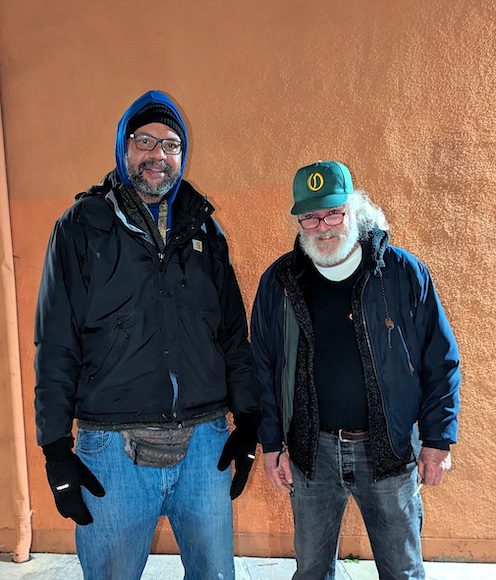Steve Stewart sits on a cot inside the old train depot building at Depot Park. On this frigid January night, he is trading the car he calls home for a bed inside one of the city of Santa Cruz’s warming centers.
“I have a car, but I have an infection in my leg […] and the doctor said I need to be indoors for it to heal,” Stewart says.
Stewart has been living out of his car for over two months after being evicted from his home, and recently was hospitalized for nearly a month due to a leg injury. This was his third night staying at the Depot Park warming center, one of three centers located in the county.
Late last year, storms battered the coast, causing widespread damage and flooding. Now, as cold weather grips the area, warming centers provide emergency shelter for individuals experiencing homelessness.
Nonprofits Come Together To Operate Warming Centers
The Depot Park warming center is run by the Santa Cruz Free Guide, a local nonprofit providing resources for homeless residents of the county, in conjunction with the city of Santa Cruz and Watsonville. The center operates when the temperature reaches 40 degrees or lower on any given night.
Last year, warming centers were open for a total of 19 nights, from January stretching into early April. During that time, the area was getting battered by atmospheric river storms that caused extensive damage throughout the county. In addition to providing a safe and warm place to sleep, the program also provides meals and a mobile shower service.
Aside from the Depot Park location, which holds 26 beds, the program offers beds at the Santa Cruz Vets Hall and the Watsonville Vets Hall. Both of those locations hold up to 40 beds.
Evan Morrison, executive director of the Free Guide, says that the warming centers in Santa Cruz have been at capacity since they opened on January 7. However, the Watsonville center has not been at capacity during the same time frame.
According to the Santa Cruz County point-in-time count, which determines how many people in the county are experiencing homelessness, in early 2023 there were 1,804 individuals unhoused. That is a drop from the 2022 number of 2,300.
Emergency shelters throughout the county offer just under 400 beds. For those that don’t have a spot at one of the shelters, the warming centers are a respite from the icy weather.
This is the second year that the Free Guide is running the warming centers, and this year the support from local government entities has helped expand the program’s reach.
Morrison says that compared to last year when they were given just two days’ notice by Santa Cruz city officials to open the centers, this year went smoother. After the program ended last year, local officials reached out to Morrison and they began planning for 2024.
Those plans included a more aggressive outreach campaign that helped spread the word and helped keep the Santa Cruz locations at full capacity, Morrison says.
Santa Cruz’s warming center program first came together a decade ago, when local group Residents for Coldest Nights Warming Centers set out to provide shelter during extreme cold or rain.
Programs like these are a lifeline for people experiencing homelessness, when extreme cold can cause hypothermia. According to the Santa Cruz County Homeless Persons Health Project, there were 122 known homeless deaths in 2023. This was a 33% increase over 2022 numbers, with drug overdoses accounting for nearly half of the deaths.
Here To Help
John Forte, a volunteer at the Depot Park center, knows personally the importance of services like the warming centers.
He experienced homelessness when he first moved to Santa Cruz from the Bay Area 13 years ago. After getting back on his feet, he began working with Housing Matters and other homelessness advocacy groups.
When he talks about how he got involved with the warming center program, he chokes up with emotion and says he’s there to help people. His mood quickly turns lighter as he recalls hearing the sounds of people sleeping comfortably during one of his shifts.
“I heard snoring last night. It’s a wonderful thing,” Forte says.
He thinks that operating the warming centers can save lives.
“A person can die from hypothermia […] it’s critical that there be something consistent, a consistent location so that people will know what to expect and know what they can get when they get there,” Forte says.
On this night, the volunteers ordered pizzas to feed everyone at the shelter.
Adam Henderson operates a mobile shower trailer parked outside the doors of the Depot Park warming center. The trailer is provided by the Association of Faith Communities.
“We come for a few hours and give people a chance to clean themselves up, feel better about themselves,” Henderson says.
He has also experienced homelessness and says that while programs like these aren’t a permanent solution, they definitely help.
“I think permanent housing is the thing that we’re looking for the most, but as far as living on the streets, it’s tough not to have a warm bed,” Henderson says.
The Depot Park warming center is open every night from 8:00 p.m. to 8:00 a.m. The Santa Cruz Vets Hall warming center is open every night from 10:00 p.m. to 8:00 a.m., and the Watsonville Vets Hall warming center is open every night from 8:00 p.m. to 8:0 a.m.













